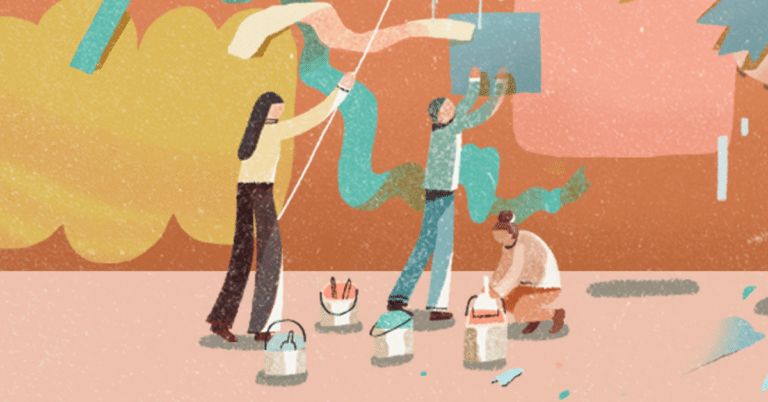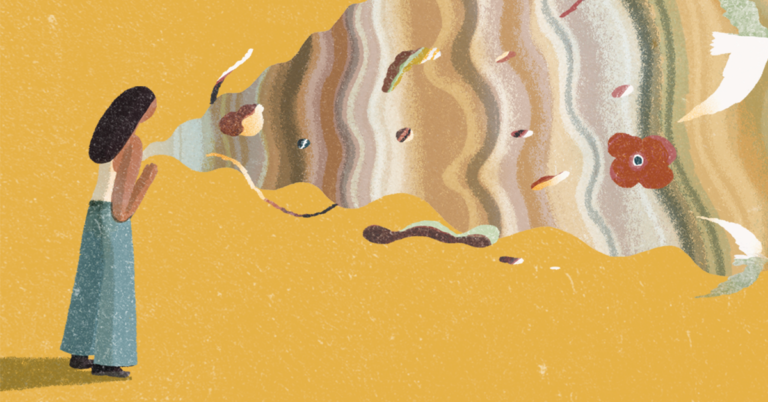Taking a Long View of Time, and Becoming "Critical Yeast"
We inhabit a liminal time between what we thought we knew and what we can’t quite yet see. But time is more spacious than we imagine it to be, and it is more of a friend than we always know. Cracking time open, seeing its true manifold nature, expands a sense of the possible in the here and the now. It sends us back to work with the raw materials of our lives, understanding that these are always the materials even of change at a cosmic or a societal level.

Transcript
Hello again.
Today, we are going to talk about time. I don’t really think there’s any more fascinating subject. And there’s surely been nothing more intriguing in all the years of On Being than coming close to people who think and work and help the rest of us get inklings of the different scales and forms of the true nature of time.
There is geological time, deep time, cosmic time, evolutionary time. And all of those are interestingly akin to a religious, prophetic imagination — the long arc of the moral universe that Martin Luther King Jr. invoked.
The ancient Greek had two very different words for time. One is Kronos, and that is time as we feel it in our bodies and in our lives, and have tried to organize our world around. That is the stuff of clocks and calendars, time as we can measure and plan and really want to rely on as kind of an arrow that’s always moving forward.
And then there is Kairos time. This is an inbreaking — a moment that disrupts everything that came before, everything you thought you knew. It can be the telephone ringing, and hearing something that will change it all. Kairos moments are these pivot points when the questions you are asking, holding, living, utterly change. Life is suddenly, unalterably defined, separated into a Before and an After. When we speak of a Kairos moment, it’s a “moment” with a capital “m” — it can be a minute; it can be a century. And I’ve come to feel increasingly that this is a way to speak of this young century we inhabit, this post-2020 world: we are in a Kairos moment as a species.
So this is all a very grand way to speak of reality. But the beautiful and mysterious thing I’ve experienced in all of this way of thinking and imagining, this way of cracking time open and seeing its true, manifold nature, is that this actually expands my sense of the possible in the here and the now. It actually sends us right back to work with the raw materials of our lives, understanding that these are always the materials even of change at a cosmic or a societal level.
So as I investigate time, I have also been gathering intelligence and understanding of how generative transformation happens in human life and in society. I’ve come across many teachers and gifts of practice and of language. I’ll just name a few for you here. The great 20th century sociologist Margaret Mead gave me this image that there are in human society, in many times and places, what she called “evolutionary clusters.” These are small groups of people who become more — and these were her words — “more purposive, conscious, and responsible.” She is also known to have made the statement: never doubt that a small group of committed people can change the world. In fact, that’s the only way it’s ever happened.
I think, also, of the wonderful civil rights elder Vincent Harding, who talked to us on On Being about what he’s seen in so many places and communities that really gave birth to life and possibility. He spoke of “live human signposts.”
I think of the journalist Gal Beckerman, who looked back at history and also in more recent history, and named the fact that what we see as big events — as ruptures, as revolutions, as progress — these things always had what he called a long “quiet before” of decades or of centuries where that change was fermenting.
I think, too, of adrienne maree brown, who is a 21st-century, next-generation emergent strategist, and how she and people in her world are taking language from mathematics about fractals — this reality in nature that patterns at a small level repeat at a large scale. And this becomes a way to talk about the outsized importance, even if we’re not aware of it, of what we’re doing at the granular level in our lives, in our present.
And finally, the phrase that I want to leave with you here, that in my mind captures all of this, is from a friend and teacher to On Being, John Paul Lederach, who is actually a global peacebuilder — a person who knows as much about conflict transformation as anyone alive in our world, who has been present and who has participated, over decades, on multiple continents, where real social transformation, real cultural evolution, has happened.
The image that he gives us that I find so helpful to work with is of “critical yeast.” He points out that when we think about how change happens in this society — and this is natural — we tell the story of those moments when critical mass arises: bodies on the street. But wherever John Paul has been, in these many places that have moved through many different kinds of conflict, preceding and leading — over years and decades and perhaps even longer — to the critical mass, there is what he calls critical yeast. This is, as he defines it, “small groups of people in unlikely combinations, in a new quality of relationship.” Importantly, he also says that it’s this critical yeast, it’s these yeasty individuals who are there in the society after the upheaval of the critical mass, who also turn what has been upended into long-term transformation.
So I’m very aware that as I describe this, what I’m describing is another way to talk about the generative narrative of our time and why it matters. It is — we are — fermenting a “quiet before” in a very frantic, hyper-reactive, deafeningly noisy world.
The invitation here is to be critical yeast. I’m joining that with our imagination about time, our understanding of the true reality of time, because to really trust in something like critical yeast in a world which emphasizes what is big, we have to really trust in a long, reality-based sense of time. We have to sink into time’s capaciousness. And that is something that I want to encourage you to try to feel in your body, as much as take in as an idea. I’ve been working at this myself for near on 20 years, and my experience — and an experience I’ve discussed with others who’ve also practiced this — is that really taking in a long view of time is such a relief. It is profoundly calming. A long view of time — a long, reality-based view of time — has a power to replenish our sense of ourselves and the world.
I’m going to give you a second image from John Paul that is perhaps a way to begin to take this into your body, to feel it and not just believe it. A teacher of his named Elise Boulding, also a great sociologist, spoke about what she called the “200-year present” that in fact each of us inhabits.
Your 200-year present, if you’d like to do this thought experiment, begins with the year of the birth of the oldest person you knew when you were a child. For me, that would have been my great-grandmother, Susanna Lower, who was in her 90s in the 1960s. And then the other boundary of that 200-year present would be the hundredth birthday of the youngest person you have held in your arms. For most of us, that’s going to be about a 200-year present that touches our lives directly and that we directly touch.
I experience the young among us to be teachers. I experience them to somehow know that time is long and know that what we’ve been walking into, what we now see, un-unseeable, before us, we have been walking into for generations, and walking out of this is going to happen in generational time, too.
And so to come back to that spacious view of time, if this is the work of the rest of our lifetimes, we have to honor and protect space and time for staying well, for staying whole. And that means we have to surround ourselves with others who can help us carry love and trust and hope for what might be weeks or months or years when that’s too much for us to ask of ourselves. If this is work for the rest of our lifetimes, we also do it on behalf of people we will never know.
That’s a lot to sit with. And you might have to live the question, first, to figure out what it means for you to be critical yeast in your world of friendship, neighborliness, work, community. It’s waiting for you already, in some part of the world you can see and touch. The adventure is to make it more conscious.
I’ll see you here next time.





